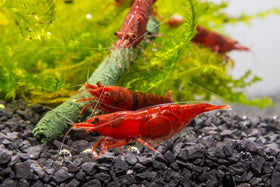
Top 10 Easy Fish for a Beginner's Planted Tank
Written by: Tammy (@aquarist_tl) and Team Buce Plant
For many aquascapers, the fauna is what completes the aquascape. After taking the time to completely set up, plant, and cycle the aquarium, it's finally time to add some real movement. With so many fish species with different care requirements, where do you even begin when deciding?
For those that are intimidated by the challenges of keeping freshwater fish, don't fret! There are plenty of species that are beginner-friendly and make great additions to planted tanks. To make choosing the perfect species easier for you, here is a list of 10 'easy' fish to take care of:
1. White Cloud Minnow (Tanichthys albonubes)
The White Cloud Mountain Minnow (also known as the Meteor Minnow), are exceptional fish that tend to get overlooked in the freshwater aquarium hobby. They are very hardy fish and are known for their ability to handle cooler water temperatures, preferring to stay around 72F. These fish stay small, maxing out at about 1.5 inches.
White Clouds are peaceful and would do well in a community tank, as long as the temperature of the aquarium doesn’t get too high. When they are kept in larger schools, they will flare their fins to compete with other White Clouds. This behavior is fun to watch, and they look even more gorgeous when they’re showing off their fins! White Clouds come in a few different variations, one of the more popular ones being the gold form.
2. Betta Fish (Betta splendens)

Bettas are a species that many new fish keepers have as their very first fish in the hobby. It’s hard to resist them once you see the large variety of colors, styles, and tail types that this species comes in! Betta fish are also known for their unique and spunky personalities. These fish usually have no trouble adapting to new environments with different water conditions. They like to be in warmer temperatures of at least 78F and reach a max of 2.5 - 3 inches.
While strikingly beautiful, they can be aggressive to other fish, especially male bettas. Male bettas should never be kept in the same tank together, as they are likely to fight to the death. It’s very common for a male betta to have its own aquarium all to itself. A nano tank like the UNS 30A or the UNS 5N would be perfect to house a betta!
If you’d like to read more about betta care and the benefits of keeping live aquarium plants with your betta, feel free to check out Keeping Bettas: Why You Need A Planted Tank!
3. Neon Tetra (Paracheirodon innesi)

Neon Tetras or Cardinal Tetras are schooling fish that beginners in tropical fishkeeping tend to start with. Their bright blue and red colors capture the attention of anyone near them! These colors bring exceptional contrast against bright green aquatic plants in an aquarium. Neon Tetras are peaceful nano fish that don’t get bigger than 1.5 inches.
They prefer to stay in groups of at least 6, so the more the merrier! They’re also a great choice for those looking for pet fish that’s budget-friendly, as they usually don’t cost as much as other fish.
4. Harlequin Rasbora (Trigonostigma heteromorpha)

If you’re looking for a species of fish that’s excellent at schooling, then look into the Harlequin Rasbora! They are a favorite choice for planted tank owners because of their schooling behavior and the look of their vibrant orange contrasting against the green of the plants. These rasboras get their name from the black patch on their bodies that resemble a pattern typically found on jester uniforms.
Harlequins are friendly fish that find safety in larger numbers, so please keep that in mind if you’re thinking of getting some. Adults reach an average length of 2 inches.
5. Platy (Xiphophorus maculatus)

Platies are beginner-friendly fish that are super active! They’re constantly swimming and darting around the tank in search of food or in an attempt to breed. They can be found in an assortment of different colors and patterns. The exact type of Platy can determine its max length, but commonly they reach 2-3 inches while dwarf species stay around 1 inch.
Platies are livebearers, meaning they give birth to live fish! All you need is a mature male and female, and the female should eventually drop young fry one by one once they have finished developing inside of her. Newborn platies are very small fish, and are highly susceptible to being eaten by other fish at this age. A planted tank with an abundance of plants like Moss or Hornwort would greatly help their chances of survival because of the hiding spaces they provide.
- Click for the Top 5 Aquarium Plants for Your Breeding Tank
Platies should readily adapt to any tank, but it’s important for livebearers to have a source of calcium. Rocks like Seiryu stone that contain calcium carbonate would be great additions to a Platy aquarium.
6. Cherry Barb (Puntius titteya)

Cherry Barbs are an excellent pick for planted tanks because of their stunning red color that stands out against a green environment. They’re a peaceful fish that would do well in community tanks and they stay small, maxing out at around 2 inches in length. Males are bright red while females are a beige/brown color with red highlights.
One thing to note is that males become even more red in the presence of females, so it’s good to have both sexes in the aquarium if possible. Cherry Barbs should be kept in groups of 6 or more.
7. Guppy (Poecilia reticulata)

Guppies are a very popular fish in the aquarium hobby because of their variations in patterns and colors, and how easy it is to breed them. They have been bred all over the world to have specific patterns and fin/tail types. There are even competitions that are held to reward breeders for the features in their show-quality guppies!
Like Platies, guppies are livebearers. Males tend to be more colorful and have larger tails, while females have less color and are larger in size. Planted tanks will help keep the young fry alive by giving them places to hide until they’re big enough to not be eaten by other fish in the aquarium.
8. Cory Catfish (Corydoras)

Cory Cats are peaceful catfish that add activity to the bottom of an aquarium. Once they sense food in the water, they start scavenging and sifting through the substrate or floor of the tank in search of it. These bottom-dwellers help to clean up the food that other fish may have missed.
Corydoras prefer not to be out in the open a lot, so providing hiding spots for them to relax in would make them feel more comfortable. Getting a group of the same species would be ideal as they also find safety in numbers. The specific species of Corydoras determines their max sizes and preferred water parameters, so please make sure to research which species would do well in your setup if you’re thinking of adding some to your aquarium.
9. Angelfish (Pterophyllum scalare)

A group of Angelfish would make a beautiful centerpiece for large planted aquariums (at least 30 gallons or bigger). They swim slowly and gracefully in their environment, giving off a very relaxing vibe. However, they can be quite aggressive at times when they are establishing dominance or pairing off to breed.
Once a pecking order is established, the fighting usually calms down, but every Angelfish has its own personality. Some always want to pick a fight while others almost never do. A larger group helps with dispersing the aggression, so that one is not always constantly being bullied. Angelfish are tall compared to other fish, so tanks with more height would be perfect for raising Angelfish!
10. Dwarf Gourami (Trichogaster)

Dwarf Gouramis are friendly and peaceful fish that display a beautiful variety of colors. Two or three Gouramis can be kept in tanks as small as 10 gallons. They will grow to a length of about 2 inches when mature. They can be found in many different color forms like the Powder Blue or Flame Gouramis. Gouramis are related to Betta fish, and share the quality of being able to breathe from the surface of the water. Males will also create bubble nests when they want to breed with a female.
Dwarf Gouramis can be shy, so giving them aquatic plants and hardscape to hide behind would help them feel safe in the tank. Overall, they’re a hardy and tranquil fish that would make a wonderful addition to a planted tank!
Tell us - Was this article helpful? Please leave a comment below!
If you have any questions regarding this article, please DM us on Instagram, Facebook, or email support@buceplant.com so we can assist you - @buceplant





Comments
Leave a comment